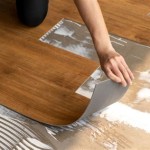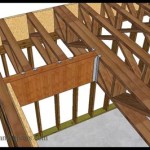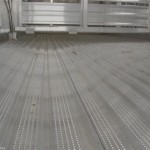Best Laminate Flooring For Kitchen And Bathroom
Laminate flooring has become a popular choice for homeowners seeking an affordable and aesthetically pleasing alternative to hardwood, tile, or stone. Its durability, ease of installation, and wide variety of styles make it a versatile option for various rooms within a house. However, when considering laminate flooring for kitchens and bathrooms, its water resistance becomes a critical factor. Choosing the right type of laminate is essential to ensure longevity and prevent damage from moisture exposure. This article will delve into the characteristics that make certain laminate flooring options suitable for these moisture-prone environments, exploring the best choices available and providing guidance on factors to consider during the selection process.
Laminate flooring is constructed in layers. Typically, there is a backing layer which provides stability and protection from subfloor moisture. Above that usually lies the core layer, often made of high-density fiberboard (HDF) or medium-density fiberboard (MDF). HDF offers greater density and, consequently, better water resistance. The decorative layer, which provides the visual appeal of the flooring (mimicking wood, tile, or stone), is printed onto a sheet of paper. Finally, a wear layer, often coated with aluminum oxide, protects the decorative layer from scratches, fading, and everyday wear and tear. The thicker the wear layer, measured in mils (thousandths of an inch), the more durable the flooring.
Understanding Water Resistance and Waterproofing
It is crucial to differentiate between water-resistant and waterproof laminate flooring. Water-resistant laminate is designed to withstand spills and splashes for a limited time. It has a protective coating and tight seams that prevent water from seeping into the core layer quickly. However, prolonged exposure to standing water will eventually lead to damage, causing the core to swell and the flooring to warp or buckle.
Waterproof laminate, on the other hand, is constructed with a completely waterproof core, often made of materials like stone plastic composite (SPC) or wood plastic composite (WPC). These materials are impervious to water, preventing any absorption or damage, even when exposed to prolonged moisture. Waterproof laminate also features a tightly sealed locking system that prevents water from penetrating through the seams. For kitchens and bathrooms, where spills and moisture are more frequent, waterproof laminate is the preferred choice.
Key Features to Look For in Kitchen and Bathroom Laminate
When selecting laminate flooring for kitchens and bathrooms, several key features should be considered:
Water Resistance/Waterproof Rating: As previously discussed, the level of water resistance is paramount. Opt for waterproof laminate whenever possible, especially in bathrooms. If considering water-resistant laminate, research the manufacturer’s specifications regarding spill resistance and cleanup guidelines. Some water-resistant laminates come with warranties that cover water damage for specified periods, providing added peace of mind.
Core Composition: The core material greatly impacts the laminate’s ability to withstand moisture. HDF cores are better than MDF, but SPC and WPC cores are the best choice for wet environments. SPC cores are particularly rigid and dimensionally stable, making them less prone to expansion and contraction with temperature and humidity fluctuations. WPC cores are lighter and can offer a slightly softer underfoot feel.
Wear Layer Thickness: A thicker wear layer provides greater protection against scratches, scuffs, and stains, which are common in high-traffic areas like kitchens. Look for a wear layer of at least 12 mils for residential use and 20 mils or higher for commercial applications. A thicker wear layer also enhances the longevity of the flooring.
AC Rating: The Abrasion Class (AC) rating indicates the laminate’s resistance to abrasion, impact, and staining. AC ratings range from AC1 to AC5, with AC5 being the most durable. For kitchens and bathrooms, an AC3 or AC4 rating is generally recommended for residential use, providing sufficient durability for everyday wear and tear.
Installation Method: Most laminate flooring uses a click-lock system for easy installation. This system allows planks to be connected without glue or nails, making installation a relatively simple DIY project. However, proper installation is crucial to ensure a watertight seal. Consider hiring a professional installer, especially for bathrooms, to guarantee a flawless installation and prevent water damage.
Seam Sealing: Even with waterproof laminate, sealing the seams can provide an extra layer of protection against water penetration. Consider using a waterproof sealant specifically designed for laminate flooring to seal the perimeter of the room and any exposed edges. This is especially important around toilets, sinks, and bathtubs.
Top Laminate Flooring Brands and Options for Kitchens and Bathrooms
Several reputable brands offer laminate flooring options suitable for kitchens and bathrooms. Researching specific product lines within these brands is crucial, as not all laminates from a given manufacturer will possess the necessary water resistance or waterproof properties. Here are a few examples of brands and products known for their suitability in moisture-prone environments:
Pergo: Pergo is a well-known brand that pioneered laminate flooring. They offer a range of laminate flooring, including some specifically designed for wet areas. Look for their Pergo Portfolio + WetProtect line, which features waterproof protection.
Mohawk: Mohawk is another leading flooring manufacturer that offers a variety of laminate options, including those with waterproof or enhanced water-resistant properties. Check their RevWood Plus collection for waterproof laminate flooring.
Shaw Floors: Shaw Floors offers a wide range of flooring products, including laminate. They have laminate options with waterproof cores and surface coatings, making them suitable for kitchens and bathrooms. Look for their Repel Water Resistant Technology.
Armstrong Flooring: Armstrong Flooring offers various laminate options, including some designed to be water-resistant or waterproof. Review their specifications carefully to ensure the product is suitable for wet environments.
COREtec: While COREtec is primarily known for its luxury vinyl plank (LVP) flooring, some of their products are technically considered composite flooring and offer exceptional waterproof performance. This can be a good alternative to traditional laminate if a completely waterproof solution is desired.
Maintenance and Care for Laminate Flooring in Kitchens and Bathrooms
Proper maintenance and care are essential to prolong the lifespan of laminate flooring in kitchens and bathrooms. Regular cleaning will help prevent the buildup of dirt, grime, and spills that can damage the flooring over time.
Regular Cleaning: Sweep or vacuum the floor regularly to remove loose dirt and debris. Use a damp mop with a mild detergent specifically designed for laminate flooring. Avoid using excessive water, as this can seep into the seams and damage the core.
Spill Cleanup: Clean up spills immediately, using a soft cloth or paper towel. Avoid using abrasive cleaners or scouring pads, as these can scratch the wear layer.
Protecting Against Scratches: Place mats or rugs in high-traffic areas, such as near doorways and sinks, to protect the flooring from scratches and scuffs. Use furniture pads under chair legs and other furniture to prevent damage.
Humidity Control: While waterproof laminate is resistant to water damage, excessive humidity can still affect its performance. Ensure proper ventilation in kitchens and bathrooms to minimize moisture buildup. Consider using a dehumidifier in particularly humid environments.
Avoid Steam Mops: Steam mops can force moisture into the seams of the flooring, potentially causing damage over time. Avoid using steam mops on laminate flooring, even if it is labeled as waterproof.
Avoid Excessive Moisture: Even with waterproof laminate, it is important to avoid prolonged exposure to standing water. Fix any leaks or plumbing issues promptly to prevent water damage to the subfloor and surrounding areas.
Considerations Beyond Water Resistance
While water resistance is the primary concern for kitchens and bathrooms, other factors should also be considered when selecting laminate flooring:
Style and Aesthetics: Laminate flooring comes in a wide variety of styles, colors, and patterns, mimicking the look of hardwood, tile, or stone. Choose a style that complements the overall decor of your kitchen or bathroom.
Budget: Laminate flooring is generally more affordable than hardwood, tile, or stone. However, the price can vary depending on the quality, features, and brand. Establish a budget before starting your search to narrow down your options.
Installation Costs: If you plan to hire a professional installer, factor in the cost of installation when calculating your budget. Installation costs can vary depending on the complexity of the project and the installer’s rates.
Warranty: Check the manufacturer’s warranty to ensure that the flooring is covered against defects, water damage, and wear and tear. A longer warranty provides greater peace of mind.
Subfloor Preparation: Before installing laminate flooring, ensure that the subfloor is level, clean, and dry. Any imperfections in the subfloor can affect the performance and longevity of the flooring.
The Importance of Professional Installation
While DIY installation of laminate flooring is possible, professional installation is often recommended, especially for kitchens and bathrooms. Professional installers have the experience and expertise to ensure that the flooring is installed correctly, with tight seams and proper sealing. They can also address any potential issues with the subfloor and ensure that the flooring is properly acclimatized to the environment.
A properly installed laminate floor will not only look better but will also be more resistant to water damage and wear and tear. The cost of professional installation is often a worthwhile investment, as it can save you money in the long run by preventing costly repairs or replacements.
Addressing Common Concerns About Laminate Flooring
Despite its popularity, laminate flooring sometimes receives criticism regarding its durability and authenticity. Addressing these concerns is important to ensure that homeowners make informed decisions.
Perceived Lack of Authenticity: Older generations of laminate flooring sometimes suffered from a lack of realism in their wood or tile patterns. However, advancements in printing technology have significantly improved the aesthetic quality of laminate flooring. Modern laminate can convincingly mimic the look and texture of natural materials, often making it difficult to distinguish from the real thing.
Durability Concerns: While not as inherently durable as solid hardwood or porcelain tile, high-quality laminate flooring with a thick wear layer and appropriate AC rating can withstand everyday wear and tear in residential environments. Proper maintenance and care can further extend its lifespan. For high-traffic areas or commercial applications, selecting a laminate with a higher AC rating is recommended.
Environmental Impact: Some consumers are concerned about the environmental impact of laminate flooring, particularly the use of formaldehyde in the core layer. However, many manufacturers now offer laminate flooring that is certified to meet low-VOC emissions standards, ensuring that it is safe for indoor air quality.

What Flooring Is Best For The Kitchen Or Bathroom

Waterproof Laminate Flooring Review Pros And Cons

How To Install Waterproof Laminate Flooring Twenty Oak

6 Best Scandinavian Flooring Options Build Your Perfect Stuga

Waterproof Laminate For Your Kitchen Bathroom Is It The Best Choice Flooring Direct

Laminate Floor Guide Lowe S

Pros And Cons Of 5 Popular Kitchen Flooring Materials

Types Of Laminate Flooring The Home Depot

What Flooring Is Best For The Kitchen Or Bathroom

Types Of Laminate Flooring The Home Depot
Related Posts








